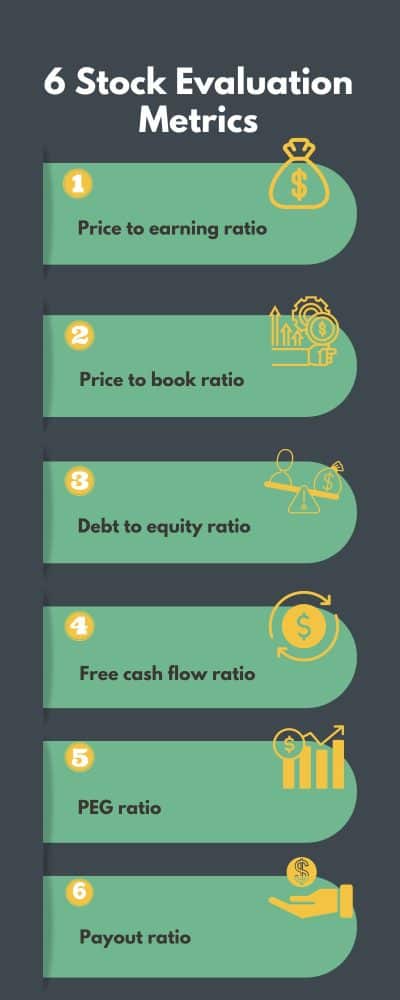There are a number of ways to build wealth through investing. One of the most popular methods is through stocks. The popularity of stock investments has grown through technological advancements. Back in the day, it could take several weeks to fill a stock purchase order with the absence of technology. But today, a stock purchase is processed in mere minutes! In addition, more financial data about companies is readily available today through the Internet. With more information at our fingertips, how do you decide what stocks to invest in? The answer to that question is possible through stock valuation metrics. Continue reading to learn more about what stock valuation is and how you can use metrics to make your next stock purchase with confidence.

Table of contents
What is stock valuation?
At any point of time, you can access information about the price of a particular stock. So isn’t that the value of a stock? In some ways, yes, but price does not necessarily equate value. To demonstrate this concept, let’s consider an example.
You go to the mall and find a shirt you like. The price tag on the shirt says $20. However, that’s what the company selling the shirt is charging you, the consumer. In actuality, the shirt has an approximate value of $15. This is the amount of money it costs the company to produce one shirt, from raw materials to labour to transportation to the store. Naturally, the company is going to charge extra for the shirt because they are in the clothing business to earn a profit.
In the example above, price was greater than the value, but the inverse can also be true. For instance, if the shirt goes on sale to $10, the value would be higher than the price. This is why people get excited about sales – they’re paying less than the true value!
As you can see, price and value aren’t always the same. And to make things more complex, there is also such a thing as perceived value. Continuing with the example above, if the shirt was sold by a popular designer brand, one person might be willing to pay $40 because their perceived value is higher. Whereas someone who doesn’t care about branding would only be willing to spend $20 because their perception of value is lower.
Now, back to stocks. The same theory from above can be applied to stocks – there is the stock price and then there’s the stock value. These two numbers are rarely the same which is where stock valuation comes into play. By assessing metrics and other information about the company behind the stock, an investor can compare price against value. Once this information is obtained, if the value is less than the stock price, chances are the investor will earn a profit through this investment.

What are the two most common valuation methods?
There are two broad buckets of stock valuation methodologies. The first is the absolute methodology which uses the company’s financials and fundamentals to discover real value. The second is the relative methodology which compares the company of interest against a similar benchmark, such as competitors or industry standards. In this article, we’ll be focusing on the absolute methodologies.
Related Reading: Best Wealth Management Books for Canadians
What are stock valuation metrics?
Stock valuation metrics are primarily ratios. Usually, ratios can reveal details about a company’s economic situation that would otherwise be concealed. But there are other methods you can use to value a stock. For instance, some use market valuation, multiples method, comparable transactions method, or the discounted cash flow (DCF) analysis.

START WORKING WITH A WEALTH MANAGER NOW
Why should you use stock valuation metrics?
The goal of investing for most individuals is to generate wealth. For most, achieving this is possible by purchasing and holding assets that appreciate in value over time. There are tons of assets you can buy to achieve this, but a common option is stocks. By using stock valuation metrics, you can improve your odds of turning a profit on a stock purchase by identifying hidden value.
Some people choose to invest in certain assets or stocks out of personal interest. In this circumstance, value to the investor may not be derived from price or the value of the asset. Rather, the investor is making a decision based on perceived value. For instance, if you really love Amazon’s service, you might buy Amazon’s stock regardless of whether there’s economic value. It is okay to invest based on your perception of value, but you should still use stock valuation metrics for other investments to contribute to the wealth you’re building.
Related Reading: The Three Phases of Managing Cash Flows
Top 6 Stock Valuation Metrics
Now that you understand what stock valuation is, it’s time to consider the various metrics you can use to assess the value against the price of a stock. As mentioned above, we’ll only be looking at absolute stock valuation metrics. To start using these ratios, you’ll need the most up to date financial statements and current stock price of the company you’re valuing
| Stock Valuation Metric | Formula |
| Price to Earning Ratio | = Stock Price / Earnings per Share |
| Price to Book Ratio | = Market Price per Share / Book Value per Share |
| Debt to Equity Ratio | = Total Liabilities / Total Equity |
| Free Cash Flow | = Cash Flow from Operations / Current Liabilities |
| PEG Ratio | = PE Ratio / Earnings Growth Rate |
| Payout Ratio | = Dividends / Total Earnings |
1. Price to Earning Ratio
Arguably one of the best stock valuation metrics, the price to earning ratio communicates how cheap or expensive a stock is. The lower the price to earning ratio is, the more undervalued a company is. In other words, when this number is low, it’s a strong indicator you should buy because the asset is priced lower than its value.
2. Price to Book Ratio
The price to book ratio assesses a company’s value on paper (its “book” value) against its market price. The lower the price to book ratio is, the more undervalued a company is. Essentially, it communicates that the market value is less than the book value. Since a company can’t be worth less than its book value (at least in a functioning market), a low price to book ratio is a good indicator.
3. Debt to Equity Ratio
Many companies take on debt to grow their operations. Better yet, debt is taken on to generate equity. However, this doesn’t always happen in practice and the debt to equity ratio can communicate that. In essence, the debt to equity ratio measures how much debt a company has relative to its assets. When the debt to equity ratio is high, a company will have trouble covering the cost of debt. This can be an indicator of poor financial health so proceed with caution. But when the debt to equity ratio is low, it’s an indicator that the company is financially healthy and investing could be a good idea.
4. Free Cash Flow Ratio
One of the profitability ratios, the free cash flow ratio assesses the cash produced by an entity after accounting for expenses, current assets and current liabilities. In other words, it communicates how much extra cash is available after paying for expenditures to continue operations. When a company has high free cash flow, it’s an indicator of great corporate health.
5. PEG Ratio
The PEG ratio builds off of the price to earnings ratio and provides a deeper picture of stock value. A PEG ratio of 1.0 or less communicates a stock is fairly valued or undervalued. If the ratio is above 1.0, it communicates the stock is overvalued.
6. Payout Ratio
Last but not least, we have the payout ratio. This stock valuation metric is used primarily for dividend paying stocks. In some cases, an investor may feel that the yield a company is promising is too good to be true. You can use the payout ratio to verify the promised yield. Naturally, the higher the payout ratio is, the more income you can expect to receive by owning the stock.
Related Reading: Passive Investing in Canada

START WORKING WITH A WEALTH MANAGER NOW
What is the best metric for stock valuation?
The best metric from above is the price to earnings ratio. This is because it’s easy to calculate and the most frequently referred to out of all absolute stock valuation metrics. However, to accurately assess the value of a stock, you should consider multiple metrics and valuations – not just one. Otherwise, you won’t be getting a complete picture of the stock’s value. With that said, the price to earnings ratio is a good metric to assess before you decide to dive in further to a stock valuation assessment.
What is the most accurate stock valuation method?
There is no such thing as the most accurate stock valuation method. If we knew for sure what would happen in the market tomorrow through stock valuation, we’d all buy accordingly! Unfortunately, even the best of investors aren’t always correct in their stock valuations. A stock valuation can be thrown off due to dated information, unexpected events in the market, errors in the data, or fraud. Ultimately, stock valuation helps you make more informed investing decisions, but there is never a guarantee that your valuation will be 100% accurate.
Using Stock Valuation Metrics for your Next Investment
Stock valuation is a skill that can be developed over time. Successful investors like Warren Buffet have developed the financial knowledge, investing experience and finesse to become quite effective in stock valuation. We encourage you to try using stock valuation metrics ahead of your next investment, but remember, the world of finance is much more than just ratios and data!
Read More: How to Invest in Private Equity